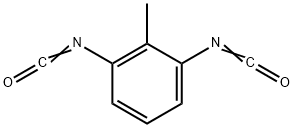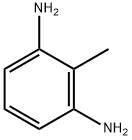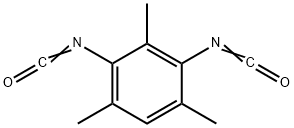2-METHYL-M-PHENYLENE DIISOCYANATE
Synonym(s):2-Methyl-m-phenylene diisocyanate;Tolylene-2,6-diisocyanate
- CAS NO.:91-08-7
- Empirical Formula: C9H6N2O2
- Molecular Weight: 174.16
- MDL number: MFCD00002010
- EINECS: 202-039-0
- SAFETY DATA SHEET (SDS)
- Update Date: 2023-08-15 17:37:19

What is 2-METHYL-M-PHENYLENE DIISOCYANATE?
Chemical properties
colourless liquid
The Uses of 2-METHYL-M-PHENYLENE DIISOCYANATE
2-Methyl-m-phenylene Diisocyanate is used in method for preparing breathable sweat-absorbing EVA foam shoe material.
The Uses of 2-METHYL-M-PHENYLENE DIISOCYANATE
2,6-TDI may be used as a reference standard for the quantification of residual 2,6-TDI in foam samples using high performance liquid chromatography coupled to coordination-ionspray tandem mass spectrometry (HPLC-CIS-MS/MS).
Definition
ChEBI: A toluene meta-diisocyanate in which the isocyanato groups are at positions 2 and 6 relative to the methyl group on the benzene ring.
Synthesis Reference(s)
The Journal of Organic Chemistry, 60, p. 257, 1995 DOI: 10.1021/jo00106a044
General Description
Liquid. Used in the manufacture of polyurethane foams, elastomers, and coatings; crosslinking agent for nylon 6.
Reactivity Profile
2-METHYL-M-PHENYLENE DIISOCYANATE reacts violently with amines, alcohols, bases and warm water, causing fire and explosion hazards. [Handling Chemcials Safely 1980. p. 907]. Reaction with water to form Carbon Dioxide [Merck 11th ed. 1989].
Health Hazard
Classified as slightly toxic orally. Probable oral lethal dose in humans is 5 to 15 g/kg or between 1 pint and 1 quart for a 70 (l50 lb.) person. Particularly poisonous when breathed. This is among the most poisonous of isocyanates. Acute and chronic exposures to low concentrations may produce asthmatic attacks.
Fire Hazard
When heated to decomposition, 2-METHYL-M-PHENYLENE DIISOCYANATE emits toxic fumes of nitrogen oxides. Ventilation should be adequate. If polyurethane products are heated, protection against isocyanate release is necessary. Avoid decomposing heat.
Flammability and Explosibility
Non flammable
Safety Profile
Confirmed carcinogen. Poison by ingestion and inhalation. Human systemic effects by inhalation: olfactory, eye, and pulmonary changes. Flammable liquid. When heated to decomposition it emits toxic fumes of NOx. See also CYANATES.
Purification Methods
It is purified by fractional distillation in a vacuum. Store it under N2 in sealed dark ampoules as it is water and light sensitive. Like the preceding 2,4-isomer, it has a sharp pungent odour, is TOXIC and is IRRITATING TO THE EYES. [Beilstein 13 IV 259.]
Properties of 2-METHYL-M-PHENYLENE DIISOCYANATE
| Melting point: | 13°C |
| Boiling point: | 129-133 °C18 mm Hg(lit.) |
| Density | 1.225 g/mL at 25 °C(lit.) |
| vapor pressure | 2.78Pa at 25℃ |
| refractive index | n |
| Flash point: | >230 °F |
| storage temp. | −20°C |
| form | Liquid |
| color | Clear colorless to light yellow |
| Water Solubility | It hydrolyzes in water. |
| Sensitive | Moisture Sensitive |
| BRN | 2211546 |
| Exposure limits | ACGIH: TWA 0.001 ppm; STEL 0.005 ppm (Skin) |
| Stability: | Stability Reacts violently with water. Reacts very rapidly with compounds containing an active hydrogen, such as amines, alcohols and acids. Polymerizes rapidly in the presence of base. Combustible. Incompatible with strong oxidizing agents. |
| CAS DataBase Reference | 91-08-7(CAS DataBase Reference) |
| EPA Substance Registry System | Toluene-2,6-diisocyanate (91-08-7) |
Safety information for 2-METHYL-M-PHENYLENE DIISOCYANATE
| Signal word | Danger |
| Pictogram(s) |
 Skull and Crossbones Acute Toxicity GHS06  Health Hazard GHS08 |
| GHS Hazard Statements |
H315:Skin corrosion/irritation H317:Sensitisation, Skin H319:Serious eye damage/eye irritation H330:Acute toxicity,inhalation H334:Sensitisation, respiratory H335:Specific target organ toxicity, single exposure;Respiratory tract irritation H351:Carcinogenicity H412:Hazardous to the aquatic environment, long-term hazard |
| Precautionary Statement Codes |
P202:Do not handle until all safety precautions have been read and understood. P273:Avoid release to the environment. P280:Wear protective gloves/protective clothing/eye protection/face protection. P302+P352:IF ON SKIN: wash with plenty of soap and water. P305+P351+P338:IF IN EYES: Rinse cautiously with water for several minutes. Remove contact lenses, if present and easy to do. Continuerinsing. |
Computed Descriptors for 2-METHYL-M-PHENYLENE DIISOCYANATE
New Products
4-AMINO-TETRAHYDRO-PYRAN-4-CARBOXYLIC ACID HCL 4-(Dimethylamino)tetrahydro-2H-pyran-4-carbonitrile 4-AMINO-TETRAHYDRO-PYRAN-4-CARBOXYLIC ACID 4-Aminotetrahydropyran-4-carbonitrile Hydrochloride (R)-3-Aminobutanenitrile Hydrochloride 5-Bromo-2-nitropyridine Nimesulide BP Aceclofenac IP/BP/EP Diclofenac Sodium IP/BP/EP/USP Mefenamic Acid IP/BP/EP/USP Ornidazole IP Diclofenac Potassium 3-Bromopyrazole (3aR,4R,5R,6aS)-hexahydro-5-Triethyl silyloxy-4-((E)-3-oxo-5-phenylpent-1- enyl)cyclopenta[b]furan-2-one. 1-Chlorocarbonyl-4-piperidinopiperidine 1-Bromo-4-phenyl-2-Butanone 4-Amino-2-fluoro-N-methylbenzamide 1,1'-Carbonyldiimidazole SODIUM AAS SOLUTION ZINC AAS SOLUTION BUFFER SOLUTION PH 10.0(BORATE) GOOCH CRUCIBLE SINTERED AQUANIL 5 BERYLLIUM AAS SOLUTIONRelated products of tetrahydrofuran








You may like
-
 Toluene-2,6-diisocyanate CAS 91-08-7View Details
Toluene-2,6-diisocyanate CAS 91-08-7View Details
91-08-7 -
 Tolylene-2,6-diisocyanate CAS 91-08-7View Details
Tolylene-2,6-diisocyanate CAS 91-08-7View Details
91-08-7 -
 Tolylene-2,6-diisocyanate CAS 91-08-7View Details
Tolylene-2,6-diisocyanate CAS 91-08-7View Details
91-08-7 -
 2,6-TDI CAS 91-08-7View Details
2,6-TDI CAS 91-08-7View Details
91-08-7 -
![Dimethyl [2-oxo-3-[3-(trifluoromethyl)phenoxy]propyl]phosphonate 99%](https://img.chemicalbook.in//Content/image/CP5.jpg) Dimethyl [2-oxo-3-[3-(trifluoromethyl)phenoxy]propyl]phosphonate 99%View Details
Dimethyl [2-oxo-3-[3-(trifluoromethyl)phenoxy]propyl]phosphonate 99%View Details
54094-19-8 -
 85-81-4 99%View Details
85-81-4 99%View Details
85-81-4 -
![208111-98-2 (3aR,4R,5R,6aS)-5-(Benzoyloxy)hexahydro-4-[(1E)-3-oxo-4-[3-(trifluoromethyl)phenoxy]-1-buten- 1-yl]-2H-cyclopenta[b]furan-2-one 99%](https://img.chemicalbook.in//Content/image/CP5.jpg) 208111-98-2 (3aR,4R,5R,6aS)-5-(Benzoyloxy)hexahydro-4-[(1E)-3-oxo-4-[3-(trifluoromethyl)phenoxy]-1-buten- 1-yl]-2H-cyclopenta[b]furan-2-one 99%View Details
208111-98-2 (3aR,4R,5R,6aS)-5-(Benzoyloxy)hexahydro-4-[(1E)-3-oxo-4-[3-(trifluoromethyl)phenoxy]-1-buten- 1-yl]-2H-cyclopenta[b]furan-2-one 99%View Details
208111-98-2 -
 Meldrums acid 2033-24-1 99%View Details
Meldrums acid 2033-24-1 99%View Details
2033-24-1